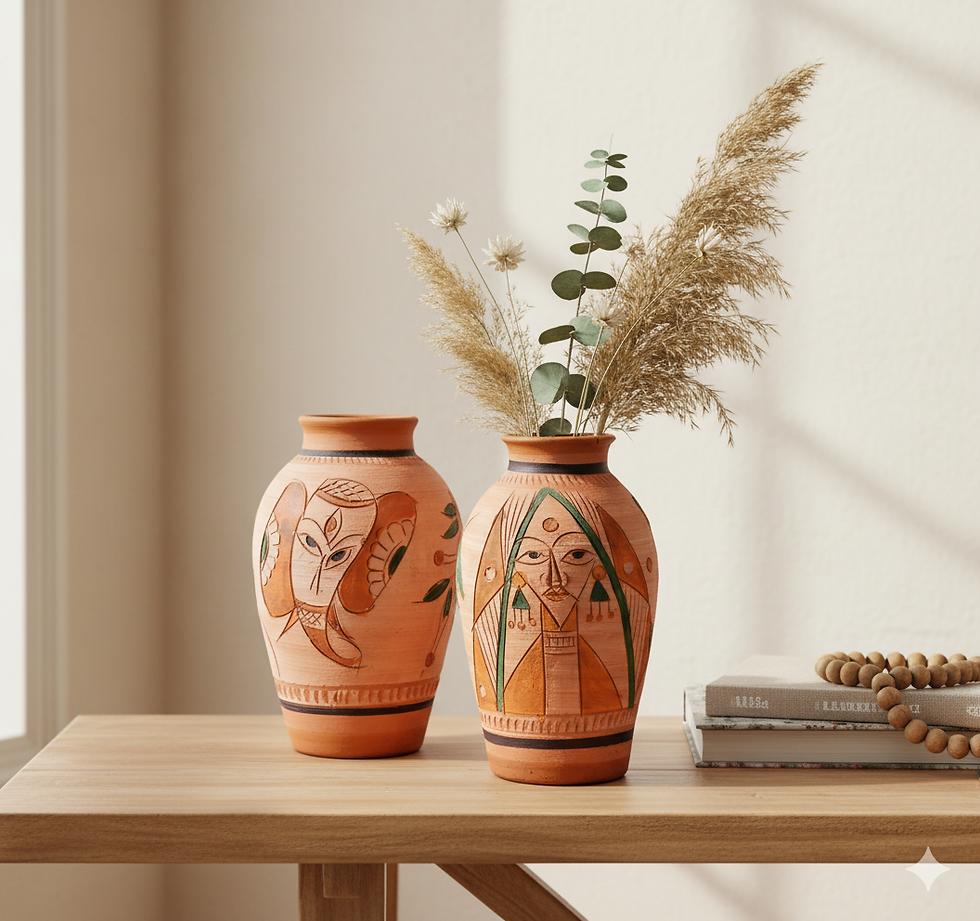The Rich Tradition of Handmade Jewelry from India
- Jul 1
- 4 min read
Updated: Jul 18
Handmade jewelry has a long-standing tradition in India, a nation renowned for its exquisite craftsmanship and unique designs. This art form reflects the rich cultural heritage of the country and is deeply intertwined with its history and rituals. Indian jewelry isn't just about adornment; it tells stories, symbolizes status, and celebrates various milestones in life.
The Allure of Handmade Jewelry
The craftsmanship behind handmade jewelry lies in its intricate details and the effort invested by skilled artisans. Due to the time-consuming nature of producing each piece, handmade jewelry often comes with a soul and narrative that mass-produced items lack. Artisans employ a rich array of materials, from precious metals like gold and silver to semi-precious stones and organic materials.

One of the defining characteristics of handmade jewelry is the ability to customize it according to personal preferences. You can choose designs, patterns, and types of materials that resonate most with you. This makes each piece distinct, turning them into treasured heirlooms passed down through generations.
The Cultural Significance of Jewelry
Jewelry holds a prominent place in various cultural and religious rituals in India. From weddings to religious ceremonies, the significance of jewelry transcends mere fashion statements. For instance, in a traditional Hindu wedding, brides often wear ornate jewelry sets known as "kadas" and "maang tikka," which symbolize wealth and prosperity.
Women from different regions of India wear unique jewelry styles that reflect their cultural identity. For example, Rajasthani jewelry is known for its chunky designs often adorned with colorful stones, while Kundan jewelry showcases intricate work with gemstones set in gold foil.

This regional diversity not only highlights India's rich cultural heritage but also contributes to the vibrancy of its jewelry market. With globalization, traditional designs have managed to find a place in contemporary fashion, making them accessible to new audiences.
What is traditional Indian jewelry called?
Traditional Indian jewelry goes by various names based on the region and style. Some of the commonly recognized types include:
Kundan: This style uses glass gems set in gold or silver, highlighting a unique technique where the stones are cut in geometric shapes.
Meenakari: This technique involves intricate enameling, resulting in colorful and vibrant designs.
Temple Jewelry: This form often features intricately carved motifs of deities and is typically worn during religious ceremonies or festivals.
These names signify not just a piece of jewelry but an entire culture and tradition behind it. Each piece is symbolic and rooted in the community it originates from.
Modernizing Tradition: The Fusion of Old and New
In recent years, there has been a fascinating blend of modern aesthetics and traditional designs. Younger artisans are taking influence from global fashion trends while retaining the essence of India's heritage. The market for handmade jewelry is growing rapidly as brands and artisans are now catering to diverse customer preferences.
The surge in online shopping has also opened avenues for aspiring jewelers to showcase their work beyond local markets. Customizations based on customer demands have become common, paving the way for unique collections that appeal to a broader audience. These new-age artisans often leverage social media platforms to share their creations, making handmade jewelry more accessible than ever.

The Craftsmanship Behind Handmade Jewelry
Creating handmade jewelry is an exacting process that requires a great deal of skill and passion. The journey begins with brainstorming designs, material selection, and skillful execution. Master craftsmen might spend days or even weeks perfecting intricate pieces, ensuring that every detail reflects their artistry.
Some artisans follow time-honored techniques passed down through generations, while others experiment with new methods to create something unique. This combination leads to a vibrant marketplace of options. Investing in handcrafted jewelry not only supports artisans but also champions the craft, ensuring that these skills and traditions are preserved.
In recent times, many artisans have begun using sustainable and eco-friendly materials in their jewelry-making process. They adhere to ethical principles, ensuring their practices do not harm the environment. Supporting such artisans allows consumers to enjoy beautiful pieces while contributing positively to the community.
Why Choose Handmade Jewelry?
Investing in handmade jewelry comes with its fair share of advantages. Firstly, you are acquiring a unique piece of art that stands apart from mass-produced goods. Every piece has a story, a background that makes it special. Secondly, handmade jewelry often utilizes superior materials, leading to better durability compared to factory-made alternatives.
Finally, purchasing handmade jewelry supports artisans and their families, promoting local economies and preserving cultural traditions. By choosing to buy jewelry from ethical sources, consumers contribute to responsible practices and the longevity of traditional crafts.
By embracing handcrafted Indian jewelry, you are not only enhancing your collection but also making a statement about your values and appreciation for skilled craftsmanship.
The Future of Handmade Jewelry in India
The future of handmade jewelry in India looks promising. With increasing global awareness around sustainability and ethical consumption, there is a growing market for handcrafted items. As digital platforms become more pervasive, artisans can reach a global audience, allowing them to diversify their offerings.
Moreover, the demand for authentic handmade jewelry means that more people are willing to pay a premium for quality craftsmanship. This trend encourages more artisans to enter the field, ensuring a revival of traditional techniques and styles.
In summary, the rich tradition of handmade jewelry from India is not just about fashion or decorations; it embodies culture, history, and art. Investing in these beautiful pieces gives you a chance to connect with a deeper narrative and cherish a remarkable legacy.
The journey through India's handmade jewelry can transform your style and support the vibrant community of artisans who keep this tradition alive. If you're interested in exploring these unique pieces, consider browsing options for handcrafted indian jewelry, where each item offers a glimpse into India's rich crafting heritage.




Comments